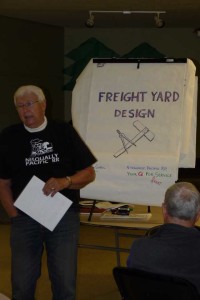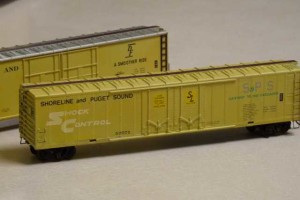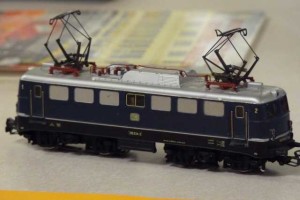By Jeff Moorman
Please join us for our next meeting, this Thursday, November 7, when our topic will be track planning software.
We’d all like to extend our thanks to Jim Sabol who came up from the Tacoma area at the last minute to be our clinician last month. Jim’s topic was “Freight Yard Design.”
What I appreciated about Jim’s approach, as opposed to many yard design presentations I have seen over the years, is that he stuck with the basics. This was information any model railroader can use, not just those who have a basement full of track and freight cars to organize. And he kept coming back to the fact that real railroads used yards to help them operate more efficiently, and model railroads should too.
Operations was another theme that kept occurring during the clinic. Jim claims everyone has space for some type of model railroad and any type of model railroad should include some aspect of operations. His basic example was a plain, wooden plank with a couple of turnouts where one could sort cars (just like a real railroad).
Jim’s next example was a long length of track with a single passing siding in the middle. He explained how this could be operated like a real railroad, moving a commodity from one end to the other. Jim reminded us that real railroads don’t move freight cars to make money – they move freight. The cars in Jim’s example were used to move beer, so he instantly had the attendees’ attention.
Of course, once you get beyond a couple of freight cars, moving beer is more efficient if you have a place to store cars that aren’t immediately in use or that cannot be loaded/unloaded right away. That’s where the freight yard starts to come in handy. And it becomes handier still if you have to move more than just one commodity, like food stuffs, building materials, petroleum, and etc. to fulfill the needs and wants of all those workers making the beer you ship.
So, once the need for a freight yard arises, there are a few basic questions to ask:
- Is it in a convenient location? Prototypically the yard needs to be near the industries and railroad facilities it services. From a model standpoint it needs to be “viewable” and “reachable.”
- Is there room to work? Typically yards are used to store and sort freight cars. If it needs to handle an average of 15 cars, then it also needs way more than 15 spot to put them in. Generally it is a good idea to leave at least one dedicated track free. This is where trains coming off the mainline can park and where trains getting ready to depart the yard can be assembled. And you’ll need a little free space on the other tracks to facilitate breaking down and assembling trains. Of course, if there are lots of trains coming and going, then you need space to put them until they can be dealt with.
- Can operations in the yard proceed without tying up the mainline? It is not very efficient to overall operations if the mainline is used every time you pull a length of cars out of a yard track. If at all possible, you need a way to work cars back and forth in the yard without using the mainline. This feature is often called a drill track or yard lead.
- Is there a way to get the locomotive back in service? Motive power is relatively expensive, so real railroads don’t like to have it “blocked in” by freight cars in the yard. You need a way to get incoming locomotives separated from their train and “back to work”.
Of course, getting all these questions answered affirmatively can be difficult on a model layout. Perhaps there is a way to get a single track feature to do double duty. For example, a run around track designed to get a locomotive off of its arriving train might also be used as the yard lead. Or perhaps a nearby industrial siding can be used to temporarily park a few cars to make more room for sorting in the yard.
Again, thanks to Jim for providing the clinic. It was quite informative.

For show and tell Dennis T brought a couple of HO box cars custom lettered for the “Shoreline & Puget Sound”. He found them at an estate sale, but no one seemed to know much about them. If you know anything about their history, please add a comment to this entry or drop me an email.

Also, Tom K brought a Maarklin HO model of a German electric locomotive. He indicated he had once actually ridden behind a locomotive like this, and it was definitely not a fast, express train like experience.

We meet at the Ronald United Methodist Church, 17839 Aurora Avenue North, Shoreline, WA. That is on the west side of Aurora (State Route 99) between 175th and 185th Streets and more specifically, between the Cadillac dealer on the south and Deseret Industries to the north. Going southbound on Aurora, make a right-hand turn into the church driveway immediately after passing the Deseret location. The parking lot is at the rear of the church. For regular meetings enter the lower, left side of the church from the rear lot.
Meetings are the first Thursday of each month, September through June. However in June we often do something different, like a layout tour. Doors open around 7:00 PM and the program starts at 7:30.
Remember the next meeting is November 7 and the clinic topic is track planning software. The meeting after that is December 5 where the scheduled topic will be N scale decoder installation. Hey, if you can install it there, you can install it anywhere! Hope to see you November 7 or at least sometime on down the line.

No Comments Yet